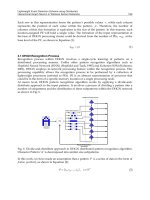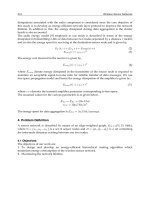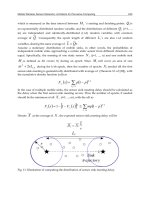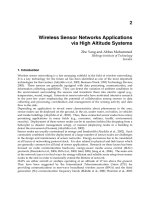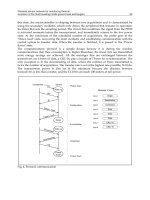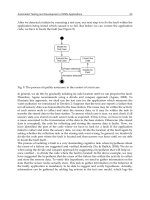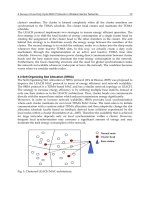Emerging Communications for Wireless Sensor Networks Part 1 ppt
Bạn đang xem bản rút gọn của tài liệu. Xem và tải ngay bản đầy đủ của tài liệu tại đây (906.99 KB, 20 trang )
Emerging Communications
for Wireless Sensor Networks
Edited by Anna Förster and Alexander Förster
Emerging Communications for Wireless Sensor Networks
Edited by Anna Förster and Alexander Fưrster
Published by InTech
Janeza Trdine 9, 51000 Rijeka, Croatia
Copyright © 2010 InTech
All chapters are Open Access articles distributed under the Creative Commons
Non Commercial Share Alike Attribution 3.0 license, which permits to copy,
distribute, transmit, and adapt the work in any medium, so long as the original
work is properly cited. After this work has been published by InTech, authors have
the right to republish it, in whole or part, in any publication of which they are the
author, and to make other personal use of the work. Any republication, referencing
or personal use of the work must explicitly identify the original source.
Statements and opinions expressed in the chapters are these of the individual contributors
and not necessarily those of the editors or publisher. No responsibility is accepted
for the accuracy of information contained in the published articles. The publisher
assumes no responsibility for any damage or injury to persons or property arising out
of the use of any materials, instructions, methods or ideas contained in the book.
Technical Editor Sonja Mujacic
Cover Designer Martina Sirotic
First published November 2010
Printed in India
A free online edition of this book is available at www.intechopen.com
Additional hard copies can be obtained from
Emerging Communications for Wireless Sensor Networks,
Edited by Anna Förster and Alexander Förster
p. cm.
ISBN 978-953-307-082-7
free online editions of InTech Books,
Journals and Videos can be found at
www.intechopen.com
Contents
Preface VII
Chapter 1
Wireless Sensor Networks:
from Application Specific to Modular Design 1
Liang Song, and Dimitrios Hatzinakos
Chapter 2
Wireless Sensor Networks
Applications via High Altitude Systems 13
Zhe Yang and Abbas Mohammed
Chapter 3
Wireless sensor network for monitoring
thermal evolution of the fluid traveling
inside ground heat exchangers 25
Julio Martos, Álvaro Montero, José Torres and Jesús Soret
Chapter 4
Automated Testing
and Development of WSN Applications 41
Mohammad Al Saad, Jochen Schiller and Elfriede Fehr
Chapter 5
A Survey of Low Duty Cycle MAC
Protocols in Wireless Sensor Networks 69
M. Riduan Ahmad, Eryk Dutkiewicz and Xiaojing Huang
Chapter 6
A new MAC Approach in Wireless Body
Sensor Networks for Health Care 91
Begonya Otal, Luis Alonso and Christos Verikoukis
Chapter 7
Throughput Analysis of Wireless Sensor Networks
via Evaluation of Connectivity and MAC performance 117
Flavio Fabbri and Chiara Buratti
Chapter 8
Energy-aware Selective
Communications in Sensor Networks 143
Rocio Arroyo-Valles, Antonio G. Marques, Jesus Cid-Sueiro
Chapter 9
Machine Learning Across the WSN Layers 165
Anna Förster and Amy L. Murphy
VI
Contents
Chapter 10
Secure Data Aggregation in Wireless Sensor Networks 183
Hani Alzaid, Ernest Foo, Juan Gonzalez Neito and DongGook Park
Chapter 11
Indoor Location Tracking using
Received Signal Strength Indicator 229
Chuan-Chin Pu, Chuan-Hsian Pu, and Hoon-Jae Lee
Chapter 12
Mobile Location Tracking Scheme for Wireless Sensor
Networks with Deficient Number of Sensor Nodes 257
Po-Hsuan Tseng, Wen-Jiunn Liu and Kai-Ten Feng
Preface
Wireless Sensor Networking is one of the most important new technologies of the
century and has been identified to see significant grow in the next decades. Wireless
sensor networks are power-efficient, small-size and communicate wirelessly among each
other to cooperatively monitor and access the properties of their targeted environments.
Applications reach from health monitoring, through industrial and environmental
monitoring to safety applications.
In this book we present some recent exciting developments of software communication
technologies and some novel applications. We hope you will enjoy reading the book as
much as we have enjoyed bringing it together for you. The book presents efforts by a
number of people. We would like to thank all the researchers and especially the chapter
authors who entrusted us with their best work and it is their work that enabled us to
collect the material for this book.
Anna Förster
Networking Laboratory, SUPSI,
Switzerland
Alexander Förster
IDSIA,
Switzerland
Wireless Sensor Networks: from Application Specific to Modular Design
1
1
X
Wireless Sensor Networks: from
Application Specific to Modular Design
Liang Song, and Dimitrios Hatzinakos
Dept. of Electrical and Computer Engineering, University of Toronto
Toronto, ON Canada
1. Introduction
The success of modular design and architecture has been observed in many fields. For
examples, in the world of computer systems, the Von Neumann architecture set forth the
fundamentals of modern computers. Equally important in computer networks is the Open
System Interconnect (OSI) architecture, where the hierarchy of layers abstracts network
functionalities and hides implementation complexities. In the multiple layers of OSI, the
physical layer defines the actual waveform being transmitted in communication medium
and the conversion of digital information bits (modulation/demodulation). The data link
layer provides the abstraction of communication channel where packets are transmitted.
The networking layer routes data packets across the network, and the transport layer
defines an end-to-end tunnel hiding the complexity of communications from high layers. A
related success story is the Internet.
Generally speaking, the benefits of modular design and architecture are: 1) it converts
complicated system into simplified layers (modules); 2) methods developed for particular
layers (modules) would benefit overall system as well; 3) modifications on a single layer
(module) would not need a system re-design. Therefore, system modular abstractions have
been important for any industrial proliferation, for example in both computer and
communication engineering.
The rapid convergence of advances in digital circuitry, wireless transceiver, and micro
electro-mechanical systems, has made it possible to integrate sensing, data processing,
wireless communication, and power supply into a low-cost inch scale device. Thus, the
potential of collaborative, robust, easily deploying, wireless sensor networks with thousands
of these inch-scale nodes have been attracting a great deal of attention. For wireless
communications and networking, the unique nature of sensor networks, which are
application-specific and resource limited, pose unique challenges.
First, the applications of wireless sensor networks need mass collaboration of a large
number of sensor nodes. Such applications, e.g., enviroment monitoring, object/asset
surveillance and tracking, utility/energy management, generate very different network
2
Emerging Communications for Wireless Sensor Networks
traffic patterns, and require different sets of application Qualtiy of Services (QoS). Before the
emerging of wireless sensor networks, the research and development in communications
and networking had been ususally focused on delivering more packets under
bandwidth/power/latency constraints. Introduced by wireless sensor networks, such
research and development are, for the first time, completely exposed to and closely
correlated with the details of applications.
Second, inch-scale sensor devices are usually subject to tight resource limitations. For
example, compared to portable devices such as smart phones and laptops that can have
battery recharge frequently, wireless sensor nodes usually do not have such privileges due
to cost constraints. Therefore, sensor nodes are usually relying on a small amount of battery
energy storagy, while at the same time are expected to operate over years. The power
constraints also introduce other resource limitions on hardware such as computing,
memory, and communication capabilities.
Consequently, the tradeoff between application QoS requirements and the resource
limitations of wireless sensor nodes has been unfound in traditional (wireless)
communciations and networking. Traditional layered architecture of communication
protocol stack has also been identified as insufficient in addressing the new challenges,
where cross-layer optimizations are needed. More specifically, the research and
development in wireless sensor networks have been calling for application specific design,
where application details determine the optimization of lower-layer protocol stack.
However, the introduction of application specific design has also been causing the loss of
architectural modularity in wireless sensor networks.
In the following, we first review the need for application specific design in wireless sensor
networks, in Section 2. We then further introduce a non-application-specific architecture,
Embedded Wireless Interconnect (EWI), which was generalized from the studies of
application specific design, but could also provide a universal platform with modular
abstractions. The abstractions of EWI are then described in Section 3. Although a single
sensor node is subject to tight resource limitations, a wireless network with thounds of
wireless sensor nodes can exploit a wealth of dynamic resources in terms of nodes/radios
and spectrum bandwidth. In Section 4, a cognitive-networking method is further introduced
to best utilize resources in large-scael wireless systems, being ideally implemented in the
abstracted modules of EWI.
From application specific to modular design, we aim to provide: an architecture with a set of
Application Programming Interface (API) functions that can decouple application
developments from the details of wireless communication/networking; an architecture with
a set of modules that can best utilize dyanmic resources in large-scale wireless systems. Both
have been prelimiarly achieved by the work of EWI.
Wireless Sensor Networks: from Application Specific to Modular Design
3
2. Application Specific Design
The need for application specific design and cross-layer optimization can be illustrated by a
simple example of wireless sensor networks. As shown in Figure 1, two sensor nodes A and
B are collecting data and sending it to the sink S in real-time.
Fig. 1. A Simplified Illustrative Example
There can be three links in this simplified network: L1 between nodes A and S; L2 between
nodes B and S; L3 between nodes B and A. Given a constant data transmission rate, it is
further assumed that the sum of packet power consumption on L1 and L3 is less than the
packet power consumption on L2. Here, “packet power consumption“ denotes the power
consumption of transmitting/receiving one data packet on the corresponding wireless
linkage.
Let’s first assume that the design objective is to minimize the sum of energy consumption on
nodes A and B. A simple think shows that application requirements decide the network
topology. For example, if data packets arrive only sporadically, link L2 can be removed,
since node B should always take the multi-hop transmission, and have node A forward the
packet, so as to minimize the total energy consumption. However, if data packets arrive
continuously in time on both nodes A and B, e.g., multimedia streaming, the “multihop“
topology will require a higher transmission data-rate on link L1. Since link power
consumption could increase exponentially with the data-rate under Gaussian assumption,
according to Shannon, C. E., 1948, it may turn out that a “star network“ is more preferable,
where link L3 can be removed. However, if some processing capability, such as data fusion,
is available on sensor nodes, node A might then compress two packets originated from the
two sensor nodes, A and B, into one single packet. Since the high data-rate problem no
longer exists, the “multihop“ topology can be more favorable again.
If the network lifetime ends when either one of the two sensors runs out of energy,
designers should balance the energy consumption between the two sensor nodes. This
lifetime would be reduced by the “multi-hop“ topology, since node A becomes a “hot spot“,
and would die much faster than node B. As one possible solution, node B might
4
Emerging Communications for Wireless Sensor Networks
probabilistically decide between the switching between the multi-hop and the direct
transmissions. The optimal value of this probability is decided by the source data-rate on
both nodes A and B.
Furthermore, due to the broadcast nature of wireless medium, when node B transmits on
link L2, node A is also able to decode the packet. If the transmission fails and is rescheduled,
many possibilities of cooperative transmission exist even among two sensor nodes. Under
our simplified channel model, node A may re-transmit the lost packet, on link L1, in order to
save energy.
The above simplified example can already demonstrated numerous ways of cross-layer
optimization in accordance with application requirements. Application specific design have
been found necessary in wireless sensor networks for dealing with sensor-device resource
limitations. Similar to what we have identified in the above simplified example, research
literatures have already identified two basic approaches to the cross-layer optimization for
wireless sensor networks.
Top down approach: it is to apply the application details to deciding network topology and
packet routing. More specifically, data/message exchanges in sensor networks are eventcentric, location-centric, and data-centric. A number of research works have been
concentrated on adapting the ad-hoc routing and network management paradigm to
accommodate the new application-specific features. For example, [Intanagonwiwat, C. et al.,
2002] developed a data-centric routing paradigm for wireless sensor networks: Directed
Diffusion; [Madden, S. et al., 2005] developed the TinyDB system which uses semantic
routing and agregration trees to set up database applications in wireless sensor networks;
similarly [Abdelzaher, T. et al., 2004] developed EnviroTrack as an applicaiton-specific
network design for environmental tracking sensor networks.
Bottom up approach: it is to utilize the broadcasting nature of wireless medium to improve
the quality and efficiency of wireless communications. For example, physical layer internode cooperation is usually neglected in traditional wireless (ad-hoc) networks, but can
offer a large performance margin in terms of reliability and energy efficiency. Both features
are of key importance in sensor-network applications. [Scaglione, A. et al., 2003] designed
Opportunistic Large Array to utilize physical-layer cooperative transmisison; [Barriac, G. et
al., 2004] studied a scheme of distributed beamforming where wireless sensor nodes can act
as elements of virtual antenna array; [Song, L. et al., 2006] was using cooperative
transmission to achieve better communicaiton reliability in wireless sensor networks.
However, both approaches need the cross-layer optimization of communication protocol
stack, therefore have caused an issue at the same time: the lost of modularity. It could be
concluded that traditional network architecture (primarily based on OSI) is not appropriate
for meeting the challengs of wireless sensor networks, and a new modular network
architecture needs to be identified from application specific designs.
Wireless Sensor Networks: from Application Specific to Modular Design
5
3. Modular Abstraction and Architecture
Embedded Wireless Interconnect is one of the first modular architecture for wireless sensor
networks. The key architectural differentiation is based on the abstract wireless linkage,
where wireless links are now redefined as arbitrary mutual cooperation among a set of
neighboring (proximity) wireless nodes. In comparison, traditional wireless networking
relies on point-to-point “virtual-wired links” with a predetermined pair of wireless nodes
and allotted spectrum. The architectural diagram of EWI is illustrated in Figure 2.
The concept of EWI was firstly proposed in some application specific studies of wireless
sensor networks, including [Song, L. et al., 2007a, 2007b]. A protocol for target tracking in
wireless sensor networks has been the first example to demonstrate the EWI architecture in
[Song, L. et al., 2007a].
Fig. 2. EWI Architecture
Three principles about the EWI architecture have been generalized from application
specific studies:
1. Functional linkage abstraction: By the functional abstractions, wireless linkage is
redefined as arbitrary functional abstraction of proximity node cooperation.
Therefore, “wireless link modules” are the building blocks for individual wireless
nodes, so as to establish different types of abstract wireless links. For example,
categories of wireless links (modules) can include: broadcast, unicast, multicast
and data aggregation, etc. At the architecture level, this results in two hierarchical
layers: the upper system layer and the lower wireless link layer. The wireless link
layer offers a library of wireless link modules to the system layer; the system layer
organizes the provided wireless link modules and API to achieve effective
application implementation.
6
Emerging Communications for Wireless Sensor Networks
2. Opportunistic wireless links: In the formation of abstract wireless links, both the
occupied spectrum and participating wireless nodes are opportunistically decided
by their instantaneous availability. This largely differentiates from traditional
wireless networking where both types of resources (spectrum and radio) are
predetermined for point-to-point wireless links. The resulting system
performance shall improve with larger network scale, since higher network
density provides more redundancy for the opportunistic utilization. This also
introduces the concept of large-scale cognitive networking that will be further
described in Section 4.
3. Global QoS decoupling: Global QoS requirements at both application and network
levels are statistically decoupled into local wireless link QoS, which are local
requirements of proximity node cooperation. By decoupling global network QoS
such as throughput, end-to-end delay and delay jitter, the wireless link module
design such as unicast or multicast can achieve global end-to-end performance
requirements. Similarly by decoupling global application QoS, the system layer
can better organize the wireless link modules that are provided by the wireless
link layer. Since wireless networking complexities are well encapsulated in the
wireless link modules, the implementation complexity at individual wireless
nodes shall be independent of network scale/size.
Like the merits of any modular architecture, the defined wireless link modules can
provide system designers with reusable open network abstractions, where the modules
can be individually updated or added in the wireless link layer. Five different wireless
link modules are illustrated in Figure 2, which are broadcast, peer-to-peer unicast,
multicast, to-sink unicast and data aggregation, respectively. Other types of wireless
link modules can be added, subject to other system design consideration. The broadcast
module simply broadcasts data to neighboring nodes; the peer-to-peer unicast module
[Song, L. et al., 2008] can reliably send data from source to destination over long
distance (multiple wireless hops); the multicast module sends data to multiple
destinations; the to-sink unicast module [Song, L. et al., 2007b] can utilize higher power
of data collectors (sinks) to achieve better data collecting; and the data-aggregation
module [Song, L. et al., 2007a] can opportunistically collect and aggregate data from
neighboring wireless sensor nodes.
EWI is an organizing-style architecture, where the system layer can manage and
organize the wireless link modules. Peer wireless link modules can exchange module
management information by putting it in the packet headers to system-layer
information units. As illustrated in Figure 2, the interface between the system layer and
the wireless link layer is defined by two service access points (SAP): the wireless link
SAP (WL SAP) and wireless link management SAP (WLME SAP) that are utilized for
the data plane and the management plane respectively. Each SAP is composed of a set
of API functions [Song, L. et al., 2009] to control the state of the wireless link layer and
link QoS.
Wireless Sensor Networks: from Application Specific to Modular Design
7
Fig. 3. State Diagram of the Wireless Link Layer
A state diagram of the wireless link layer can be illustrated in Figure 3. The wireless
link layer remains in the IDLE state, when no wireless link module is invoked. A pair of
primitives (API functions) can be utilized for the switching between the IDLE state and
the SLEEP state (power-saving mode). In the IDLE state, the wireless link layer keeps
monitoring if there are new abstract wireless links being initiated. Once an initiation
from any neighboring nodes is detected, the wireless link layer transfers from the IDLE
state to the Module Request state. This provides the system layer with the control of
wireless link activities, so that the wireless link layer would either transfer back to the
IDLE state or join in the new abstract wireless link, as decided by the system response.
On the other hand, once receiving a command to initiate an abstract wireless link, the
wireless link layer transfers from the IDLE state to the Spectrum Sensing state; a
wireless link module would be then started after available spectrum resource being
opportunistically located.
Fig. 4. Commercial Hardware/SDK based on EWI
8
Emerging Communications for Wireless Sensor Networks
An implementation of the EWI architecture for wireless sensor networks, including
hardware platform and SDK (Software Development Kits), is now commercially
offered by OMESH Networks Inc. (Toronto, Canada URL: www.omeshnet.com). The
system has been used in commercial applications including wireless location and
monitoring/controlling sensor networks in agriculture, mining, electricity,
environmental monitoring, and industrial controlling. It has also been used for sensor
network test-bed in academic research including a number of projects in the University
of Toronto.
4. Cognitive Networking Method
As described previously, both the operating spectrum and participating nodes are
opportunistically decided for an abstract wireless link under the EWI architecture. This
introduces the concept of large-scale cognitive networking [Song, L. et al., 2009] which
can best utilize network resources in large-scale wireless systems, such as the
applications of wireless sensor networks. The networking concept is one-step further of
cognitive radio [Zhao, Q. et al., 2007], and creates dynamic and real-time network with
unlimited scalability.
Fig. 5. Cognitive Networking Concept
In principle, large-scale cognitive networking is highly differentiated from traditional
wireless networking, by its opportunistic network resource utilization of both spectrum
bandwidth and wireless node/radio availability. On the contrary, traditional wireless
networking assumes that those resources can be predetermined.
The cognitive-networking method creates a dynamic (fluid) wireless network without
predetermined topology and spectrum allocation. For example, in multi-hop wireless
communications, every packet takes opportunistically available paths in the wireless
Wireless Sensor Networks: from Application Specific to Modular Design
9
network, and with opportunistically available spectrum on every hop. The networkresource utilization can thereby reach its instantaneous maximum, disregarding
volatile changes and the demand placed on the network. In large-scale wireless
networks such as wireless sensor networks, the problem of volatile spectrum
availability is typical in unlicensed bands where interference prevails. Similarly, the
problem of random radio availability is also often encountered due to the dynamic
traffic load and other factors such as radio failure. In dynamic wireless environment,
traditional wireless networking seldom functions properly, given its assumption of
predetermined “virtual-wired” links and network topology for (ad-hoc) network
routing protocols. As a result, almost every today’s real-world wireless network is
based on single-hop wireless (e.g., cellular networks, WLAN – wireless local area
networks) rather than a true multi-hop mesh.
A set of key comparative advantages of the cognitive-networking method is further
explained as follows:
Dynamic network planning and deployment model:
No deterministic network topology has to be maintained, because the wireless
node/radio resource is opportunistically utilized. The wireless sensor nodes, when
implemented with the cognitive-networking method, become “drop-and-play” in the
network deployment. Inserting more radios/nodes can improve the radio resource to
be opportunistically exploited, and therefore increase the network capacity. Likewise
removing any individual radio/node does not create bottlenecks in the network. This
fluid “drop-and-play” nature offers the potential of vast cost-saving in network
planning and deployments. The setup of wireless radio/node does not need expensive
planning and calibration, as multi-tier new deployments (for example introduced by
operators) guarantee improved network capacity. High mobility of the nodes/radios
can be supported.
Better network resource utilization:
The network resource in large-scale wireless networks includes: the amount of
spectrum bandwidth and the number of wireless nodes/radios. Theoretical network
capacity is decided by the network resources, and the multiplication of these two
factors. Traditional wireless networking depends on a deterministic network topology.
It is therefore difficult to efficiently utilize the network resources, subject to a dynamic
wireless networking environment where both spectrum bandwidth and radio
availability cannot be predetermined. The cognitive networking method offers a means
of better network-resource utilization, approaching the information-theoretical limit on
wireless-network capacity.
Supporting guaranteed real-time services:
Due to the opportunistic network-resource utilization, reliable wireless
communications with specified dataflow throughput, end-to-end delay, and delay
variance can be supported over multiple wireless hops. Therefore, real-time services,
10
Emerging Communications for Wireless Sensor Networks
including multimedia streaming, can be supported by the cognitive-networking
method. In order to better understand this, note that the opportunistic exploitation of
local random-networking environment can result in overall-reliable end-to-end
communications. Dataflow throughput is independent of the number of wireless hops;
end-to-end delay and delay variance only increase linearly with the number of wireless
hops; and delay variance can also diminish to zero with higher network density.
Therefore, network operators only need to assure that sufficient network resources are
deployed to support their applications, so as to provide guaranteed services of realtime communications, where the resources, e.g., gateway capacity and nodes/radios,
can be deployed with low cost.
Robust to wireless interferences:
Due to the opportunistic network-resource utilization of spectrum bandwidth, the
network is very robust to interferences which can be substantial in unlicensed spectrum
bands (e.g., ISM bands). For example, viable operation within unlicensed bands can
bring large free bandwidth to wireless sensor networks, which results in large network
capacity with virtually zero cost.
Compatibility with current industrial standards:
The cognitive-networking method can be compatible with all established wireless radio
standards, so that the implementation can be independent of physical radios.
Therefore, the radio modules (with cognitive-networking capabilities) can use off-theshelf RF chips which offer relatively low cost. The implementation can also be
seamlessly integrated with all network-layer protocols, including for example Internet
Protocols.
Supporting scalable radio complexity (low power):
The complexity of individual radio modules (with cognitive-networking capabilities) is
low and independent of network scale/size. The low radio complexity results in lower
power consumption, lower cost, and longer battery life. When needed, it also makes it
possible to power the wireless node by cost-effective solar panel, which will further
reduce installation cost by removing any cable attachment.
Better economics and business case (low cost):
As explained above, the cognitive-networking method can offer excellent economics in
large-scale wireless systems including wireless sensor networks, by which 1) the costs
of deploying network resources could be vastly reduced by the utilization of
unlicensed spectrum bands and drop-and-play (mobile) wireless nodes; 2) much higher
efficiency in network-resource utilization results in excellent performance with all the
available resources being used to their instantaneous maximum.
Wireless Sensor Networks: from Application Specific to Modular Design
11
5. Conclusion
In this chapter, we have not only reviewed the need for application-specific network
design in the current research of wireless sensor networks, but also have pointed out
the need for appropriate modular abstractions or network architecture. System
modular abstractions are important for any industrial proliferation of computer and
communication systems, where any modification and improvement of one layer or
module would not need a system re-design.
We then introduced one of the first modular architecture for wireless sensor networks,
Embedded Wireless Interconnect. The abstractions of EWI take a layered architecture,
and hide networking complexities from application design in large-scale wireless
systems, by the redefinition of wireless linkage. Modular abstractions are given on
wireless links, and a set of API functions can be provided for the system to organize
and manage the wireless link modules. Major resources in large-scale wireless
networks, including both spectrum bandwidth and wireless nodes (radios) are
opportunistically utilized in the construction of abstract wireless links, according to the
cognitive-networking method. Therefore, the modular architecture of EWI creates lowcomplexity wireless sensor networks that can efficiently deal with dynamic changes
typically in large-scale wireless environment, and ensure reliable application-level QoS
at the same time, addressing the major challenges in wireless sensor networks.
6. References
Shannon, C. E. (1948). A Mathematical Theory of Communications, Bell Syst. Tech. Journal,
Vol. 27, pp. 379-423, 623-656.
Intanagonwiwat, C.; Govindan, R., Estrin, D., Heidemann, J. & Silva, F. (2002). Directed
Diffusion for Wireless Sensor Networking, ACM/IEEE Transactions on Networking,
Vol. 11, No. 1, pp. 2-16.
Madden, S.; Franklin, M. J.; Hellerstein, J. M. & Hong, W. (2005). “TinyDB: An Acquisitional
Query Processing System for Sensor Networks”, ACM Trans. on Database Systems,
Vol. 30, No. 1, pp. 122-173.
Abdelzaher, T.; Blum, B.; Cao, Q.; Chen, Y.; Evans, D.; George, J.; George, S.; Gu, L.; He, T.;
Luo, L.; Son, S.; Stoleru, R.; Stankovic, J. & Wood, A. (2004). EnviroTrack: Toward
an Environmental Computing Paradigm for Distributed Sensor Networks, in Proc.
24th International Conference on Distributed Computing Systems (ICDCS), pp. 582-589.
Scaglione, A. & Hong, Y. W. (2003). Opportunistic Large Arrays: Cooperative Transmission
in Wireless Multihop Ad hoc Networks to Reach Far Distances, IEEE Trans. on
Signal Processing, Vol. 51, No. 8, pp. 2082-2092.
Barriac, G.; Mudumbai, R. & Madhow, U. (2004). Distributed Beamforming for Information
Transfer in Sensor Networks, in Proc. the Third International Symposium on
Information Processing in Sensor Networks, pp. 81-88, Berkeley, CA.
Song, L. & Hatzinakos, D. (2006). Cooperative Transmission in Poisson Distributed Wireless
Sensor Networks: Protocol and Outage Probability, IEEE Trans. on Wireless
Communications,Vol. 5, No. 10, pp. 2834-2843.
12
Emerging Communications for Wireless Sensor Networks
Song, L. & Hatzinakos, D. (2007a). A Cross-layer Architecture of Wireless Sensor Networks
for Target Tracking, IEEE/ACM Trans. on Networking, Vol. 15, No. 1, pp. 145-158.
Song, L. & Hatzinakos, D. (2007b). Architecture of Wireless Sensor Networks with Mobile
Sinks: Sparsely Deployed Sensors, IEEE Trans. on Vehicular Technology, Vol. 56, No.
4, Part 1, pp. 1826-1836.
Song, L. & Hatzinakos, D. (2008). Real Time Communications in Large Scale Wireless
Networks, International Journal of Digital Multimedia Broadcasting, ID 586067, DOI:
10.1155/2008/586067.
Song, L. & Hatzinakos, D. (2009). Cognitive Networking of Large Scale Wireless Systems,
International Journal of Communication Networks and Distributed Systems, Vol. 2, No. 4,
pp. 452-475.
Zhao, Q. & Sadler, B. (2007). A Survey of Dynamic Spectrum Access, IEEE Signal Processing
Magazine, Vol. 24, No. 3.


